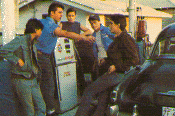Better access to adult mass-market distribution is a desirable but tough goal. YA fiction should be a genre in the adult sections of paperback racks as are romances, westerns, et al., rather than afterthoughts in children's sections. The YA world has to confront honestly the tough aspects of teen life rather than adulterated and often hypocritical approaches to life. It is utterly foolish to think the average 12- to 16-year-old unable to handle serious subjects which they see in every other media. Two non YA writers, Francesca Lia Block and Chris Lynch (both HarperCollins), are publishing in new directions which explore the most intimate of their experiences, sex and family violence. Yet their sales do not approach their potential audience response.
So, are we left only with hope? The hope the writers convey to their readers? Yes, but hope tied to action. It is our job, each of us, to redefine and relocate our goals. It can be done and the young people will be enriched. That recognition of ourselves as readers and caring human bemgs has served us over the decades. And it will do so again.
George M. Nicholson is currently a literary agent with Sterling Lord Literistic, Inc.

